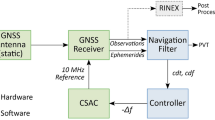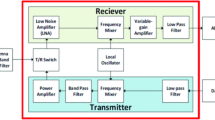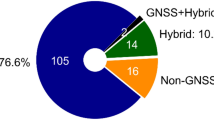Abstract
To obtain accurate demodulation of the spinning frequency of MEMS carrier-driven gyro output signal, a frequency estimation algorithm combining the real and imaginary parts on the basis of fast Fourier transformation (FFT) coefficient was proposed. Both signal simulation and real-time test were performed to verify the advantages of FFT coefficient frequency estimation algorithm. In the signal simulation, CCS software was used in the demodulation and error analysis of the spinning frequency of gyro signal simulated by signal generator. Results showed that the maximum relative error of spectrum detection algorithm is 2.53%, and the maximum relative error of FFT frequency estimation algorithm is 0.1%. In the real-time test, demodulation and error analysis of the spinning frequency of gyro signal were conducted under real-time test through three-axis precise turntable. The maximum relative error of spectrum detection algorithm is 2.33%, and the maximum relative error of FFT frequency estimation algorithm is 0.1%. Experimental results indicated that, compared with spectrum detection algorithm, FFT frequency estimation algorithm exhibits higher demodulation precision, reduced maximum relative error by 2.23–2.43%, and is convenient for hardware implementation.






Similar content being viewed by others
References
Chen TH, Ren SJ, Wei Y (2011) Teach you how to learn DSP-based on TMS320C55x. Beijing University of Aeronautics and Astronautics Press, Beijing, pp 37–60
Graney CM (2011) Coriolis effect, two centuries before coriolis. J Phys Today 64(8):8–9
Hou PW, Yang L, Wang JJ (2013) Frequency estimation algorithm of sine signal based on FFT coefficient. J Electro-Opt Technol Appl 28(6):58–62
Hu GH (2003) Digital signal processing-theory, algorithm and implementation. Tsinghua University Press, Beijing, pp 259–358
Konovalv SF, Kuleshov AV, Podtchezertsev VP, Mayorov DV (2003) Vibrating angular rate sensor. In: Integrated navigation systems proceedings of 10th international conference. St Petersburg, pp 107–117
Lang W (1996) Silicon microstructuring technology. Mater Sci Eng R Rep 17:1–55
Liu Y, Wang XQ (2006) Experiment and simulation on coupling action of three-axis motion turntable. J Aviat Precis Manuf Technol 42(3):24–27
Liu X, Ren Y, Chu C, Fang W (2015) Accurate frequency estimation based on three-parameter sine-fitting with three FFT samples. J Metrol Meas Syst 22(3):403–416
Reza Ghodssi PL (2011) MEMS materials and processes handbook. Springer, New York, pp 1067–1076
Santamaría I, Pantaleón C, Ibañez J (2000) A comparative study of high-accuracy frequency estimation methods. J Mech Syst Signal Process 14(5):819–834
Wang L, Zhang FX (2010) Analyses on output signal of MEMS gyroscope applied to low speed rotating carrier. In: IEEE international conference on information and…, pp 960–964
Wang L, Zhang F. X (2010) A novel silicon micromechanical gyroscope can be used in non-rotating or rotating flight carriers. In: Proceedings of 2010 international symposium on inertial technology and navigation. Nan Jing, China, pp 215–225
Wang W, Lv X, Sun F (2013a) Design of a novel MEMS gyroscope array. J Sens 13(2):1651–1663
Wang L, Zhang FX, Song XH, Chen XF, Cai XQ, Zhang YY, Shi XC (2013b) Posture demodulation study on carriers measured by a novel MEMS gyroscope. Adv Mater Res 718–720:989–993
Xiao W, Tu YQ, Su D (2012) A frequency estimation algorithm based on spectrum correlation of multi-section sinusoids with the known frequency-ratio. 10th World Congr Intell Control Autom (WCICA) 1109(10):4385–4389
Zhang FX, Zhang W (2007) Influence of the rotator’s spinning instability on the stability of Si micro-machined gyroscope. J Chin Inert Technol 15(5):585–588
Zhang FX, Wang HW, Mao X, Zhang N (2005) A silicon mircomachined gyroscope driven by rotating carrier itself. J Piezoelectr Acoustoopt 27(2):109–115
Zhang FX, Wang HW, Zhang W, Mao X, Zhang N (2006) Design and performance test of a silicon micromachined gyro driving by rotating carrier. J Electron Compon Mater 25(12):20–26
Zhang ZP, Zhang FX, Zhang W (2013) Measurement of phase difference for micro-machined gyros driven by rotating aircraft. J Sens 13(8):11051–11068
Zhang ZP, Zhang FX, Zhang W, Liu Y, Zhang N (2014) Modal analysis on sensing element of no-driven micromechanical gyro. J Chin Inert Technol 22(5):655–659
Acknowledgements
This work was supported by the National Natural Science Foundation of China (Grant no. 61372016), the National Natural Science Foundation of China (Grant no. 61563038), the Program of Beijing Key Lab for Sensor (no. 2016XXX) and Supported by Program for Innovative Research Team in Universities of Inner Mongolia Autonomous Region (Grant no. NMGIRT-A1609).
Author information
Authors and Affiliations
Corresponding author
Rights and permissions
About this article
Cite this article
Wang, L., Zhang, W., Zhang, Zp. et al. Spinning frequency estimation algorithm of MEMS gyro’s output signal based on FFT coefficient. Microsyst Technol 24, 1789–1793 (2018). https://doi.org/10.1007/s00542-017-3537-z
Received:
Accepted:
Published:
Issue Date:
DOI: https://doi.org/10.1007/s00542-017-3537-z




